Cadaver Dogs and the Deathly Hallows—A Survey and Literature Review on Selection and Training Procedure
Simple Summary
Abstract
1. Introduction
2. Methods
3. Selection of Human Remains Detection Dogs
4. Training of Human Remains Detection Dogs
5. Conclusions
Author Contributions
Funding
Acknowledgments
Conflicts of Interest
References
- Rebmann, A.; David, E.; Sorg, M. Cadaver Dog Handbook; Press, C., Ed.; CRC Press: New York, NY, USA, 2000; ISBN 0849318866. [Google Scholar]
- Komar, D. The Use of Cadaver Dogs in Locating Scattered, Scavenged Human Remains: Preliminary Field Test Results. J. Forensic Sci. 1999, 44, 405–408. [Google Scholar] [CrossRef] [PubMed]
- Migala, A.F.; Brown, S.E. Use of human remains detection dogs for wide area search after wildfire: A new experience for texas task force 1 search and rescue resources. Wilderness Environ. Med. 2012, 23, 337–342. [Google Scholar] [CrossRef] [PubMed]
- Nizio, K.D.; Ueland, M.; Stuart, B.H.; Forbes, S.L. The analysis of textiles associated with decomposing remains as a natural training aid for cadaver-detection dogs. Forensic Chem. 2017, 5, 33–45. [Google Scholar] [CrossRef]
- Oesterhelweg, L.; Kröber, S.; Rottmann, K.; Willhöft, J.; Braun, C.; Thies, N.; Püschel, K.; Silkenath, J.; Gehl, A. Cadaver dogs—A study on detection of contaminated carpet squares. Forensic Sci. Int. 2008, 174, 35–39. [Google Scholar] [CrossRef] [PubMed]
- Riezzo, I.; Neri, M.; Rendine, M.; Bellifemina, A.; Cantatore, S.; Fiore, C.; Turillazzi, E. Cadaver dogs: Unscientific myth or reliable biological devices? Forensic Sci. Int. 2014, 244, 213–221. [Google Scholar] [CrossRef]
- Rust, L.T.; Nizio, K.D.; Wand, M.P.; Forbes, S.L. Investigating the detection limits of scent-detection dogs to residual blood odour on clothing. Forensic Chem. 2018, 9, 62–75. [Google Scholar] [CrossRef]
- Van Denhouwe, B.; Schotsmans, E.M.J. DVI Belgium: Victim Identification and Necrosearch. Forensic Archaeol. A Glob. Perspect. 2014, 9–17. [Google Scholar] [CrossRef]
- Quignon, P.; Rimbault, M.; Robin, S.; Galibert, F. Genetics of canine olfaction and receptor diversity. Mamm. Genome 2012, 23, 132–143. [Google Scholar] [CrossRef]
- Frederickx, C.; Verheggen, F.J.; Haubruge, E. Biosensors in forensic sciences. Biotechnol. Agron. Soc. Environ. 2011, 15, 449–458. [Google Scholar]
- Hall, N.J.; Smith, D.W.; Wynne, C.D.L. Training domestic dogs (Canis lupus familiaris) on a novel discrete trials odor-detection task. Learn. Motiv. 2013, 44, 218–228. [Google Scholar] [CrossRef]
- Harper, R.J.; Furton, K.G. Biological detection of explosives. In Counterterrorist Detection Techniques of Explosives; Elsevier Science B.V.: Amsterdam, The Netherlands, 2007; pp. 395–431. ISBN 9780444522047. [Google Scholar]
- Rendine, M.; Fiore, C.; Bertozzi, G.; De Carlo, D.; Filetti, V.; Fortarezza, P.; Riezzo, I. Decomposing Human Blood: Canine Detection Odor Signature and Volatile Organic Compounds. J. Forensic Sci. 2018, 1–6. [Google Scholar] [CrossRef] [PubMed]
- Sacharczuk, M.; Walczak, M.; Adamkiewicz, E.; Walasek, A.; Ensminger, J.; Presch, M.; Jezierski, T. Polymorphism of olfactory and neurotransmitters receptor genes in drug and explosives detection dogs can be associated with differences in detection performance. Appl. Anim. Behav. Sci. 2019, 215, 52–60. [Google Scholar] [CrossRef]
- Chen, R.; Irwin, D.M.; Zhang, Y.P. Differences in selection drive olfactory receptor genes in different directions in dogs and wolf. Mol. Biol. Evol. 2012, 29, 3475–3484. [Google Scholar] [CrossRef]
- Lesniak, A.; Walczak, M.; Jezierski, T.; Sacharczuk, M.; Gawkowski, M.; Jaszczak, K. Canine olfactory receptor gene polymorphism and its relation to odor detection performance by sniffer dogs. J. Hered. 2008, 99, 518–527. [Google Scholar] [CrossRef]
- Mombaerts, P.; Wang, F.; Dulac, C.; Chao, S.K.; Nemes, A.; Mendelsohn, M.; Edmondson, J.; Axel, R. Visualizing an Olfactory Sensory Map. Cell 1965, 18, 385–387. [Google Scholar] [CrossRef]
- Quignon, P.; Giraud, M.; Rimbault, M.; Lavigne, P.; Tacher, S.; Morin, E.; Retout, E.; Valin, A.S.; Lindblad-Toh, K.; Nicolas, J.; et al. The dog and rat olfactory receptor repertoires. Genome Biol. 2005, 6. [Google Scholar] [CrossRef] [PubMed]
- Beebe, S.C.; Howell, T.J.; Bennett, P.C. Using Scent Detection Dogs in Conservation Settings: A Review of Scientific Literature Regarding Their Selection. Front. Vet. Sci. 2016, 3, 1–13. [Google Scholar] [CrossRef] [PubMed]
- Polgár, Z.; Kinnunen, M.; Ujváry, D.; Miklósi, A.; Gácsi, M.; Újváry, D.; Miklósi, Á.; Gácsi, M. A test of canine olfactory capacity: Comparing various dog breeds and wolves in a natural detection task. PLoS ONE 2016, 11, 1–14. [Google Scholar] [CrossRef] [PubMed]
- Tomkins, L.M.; Thomson, P.C.; McGreevy, P.D. Behavioral and physiological predictors of guide dog success. J. Vet. Behav. Clin. Appl. Res. 2011, 6, 178–187. [Google Scholar] [CrossRef]
- Wilsson, E.; Sundgren, P.E. The use of a behaviour test for the selection of dogs for service and breeding, I: Method of testing and evaluating test results in the adult dog, demands on different kinds of service dogs, sex and breed differences. Appl. Anim. Behav. Sci. 1997, 53, 279–295. [Google Scholar] [CrossRef]
- Coppinger, R.; Coppinger, L.; Skillings, E. Observation on assistance dog training and use. J. Appl. Anim. Welf. Sci. 1998, 1, 133–144. [Google Scholar] [CrossRef] [PubMed]
- Feng, L.C.; Howell, T.J.; Bennett, P.C. How clicker training works: Comparing Reinforcing, Marking, and Bridging Hypotheses. Appl. Anim. Behav. Sci. 2016, 181, 34–40. [Google Scholar] [CrossRef]
- Ziv, G. The effects of using aversive training methods in dogs—A review. J. Vet. Behav. Clin. Appl. Res. 2017, 19, 50–60. [Google Scholar] [CrossRef]
- Harper, R.J.; Almirall, J.R.; Furton, K.G. Identification of dominant odor chemicals emanating from explosives for use in developing optimal training aid combinations and mimics for canine detection. Talanta 2005, 67, 313–327. [Google Scholar] [CrossRef] [PubMed]
- Stadler, S.; Stefanuto, P.-H.; Byer, J.D.; Brokl, M.; Forbes, S.L.; Focant, J.-F. Analysis of synthetic canine training aids by comprehensive two-dimensional gas chromatography-time of flight mass spectrometry. J. Chromatogr. A 2012, 1255, 202–206. [Google Scholar] [CrossRef]
- Dekeirsschieter, J.; Stefanuto, P.-H.; Brasseur, C.; Haubruge, E.; Focant, J.-F. Enhanced characterization of the smell of death by comprehensive two-dimensional gas chromatography-time-of-flight mass spectrometry (GCxGC-TOFMS). PLoS ONE 2012, 7. [Google Scholar] [CrossRef] [PubMed]
- Martin, C.; Verheggen, F. Odour profile of human corpses: A review. Forensic Chem. 2018, 10, 27–36. [Google Scholar] [CrossRef]
- Focant, J.-F.; Stefanuto, P.-H.; Brasseur, C.; Dekeirsschieter, J.; Haubruge, E.; Schotsmans, E.M.J.; Wilson, A.S.; Stadler, S.; Forbes, S.L. Forensic cadaveric decomposition profiling by GCxGC-TOFMS analysis of VOCs. Kazakh Bull. Chem. Ser. 2013, 4, 177–186. [Google Scholar] [CrossRef]
- Perrault, K.A.; Nizio, K.D.; Forbes, S.L. A Comparison of One-Dimensional and Comprehensive Two-Dimensional Gas Chromatography for Decomposition Odour Profiling Using Inter-Year Replicate Field Trials. Chromatographia 2015, 78, 1057–1070. [Google Scholar] [CrossRef]
- Stefanuto, P.-H.; Perrault, K.A.; Stadler, S.; Pesesse, R.; Leblanc, H.N.; Forbes, S.L.; Focant, J.-F. GC × GC-TOFMS and supervised multivariate approaches to study human cadaveric decomposition olfactive signatures. Anal. Bioanal. Chem. 2015, 407, 4767–4778. [Google Scholar] [CrossRef]
- Agapiou, A.; Zorba, E.; Mikedi, K.; McGregor, L.; Spiliopoulou, C.; Statheropoulos, M. Analysis of volatile organic compounds released from the decay of surrogate human models simulating victims of collapsed buildings by thermal desorption-comprehensive two-dimensional gas chromatography-time of flight mass spectrometry. Anal. Chim. Acta 2015, 883, 99–108. [Google Scholar] [CrossRef]
- Dekeirsschieter, J.; Verheggen, F.J.; Gohy, M.; Hubrecht, F.; Bourguignon, L.; Lognay, G.; Haubruge, E. Cadaveric volatile organic compounds released by decaying pig carcasses (Sus domesticus L.) in different biotopes. Forensic Sci. Int. 2009, 189, 46–53. [Google Scholar] [CrossRef]
- Janaway, R.C.; Percival, S.L.; Wilson, A.S. Decomposition of human remains. In Microbiology and Aging; Humana Press: New York, NY, USA, 2009; pp. 275–289. ISBN 978-1-58829-640-5. [Google Scholar]
- Rosier, E.; Loix, S.; Develter, W.; Van de Voorde, W.; Tytgat, J.; Cuypers, E. Time-dependent VOC-profile of decomposed human and animal remains in laboratory environment. Forensic Sci. Int. 2016, 266, 164–169. [Google Scholar] [CrossRef]
- Cernosek, T.; Eckert, K.E.; Carter, D.O.; Perrault, K.A. Volatile Organic Compound Profiling from Postmortem Microbes using Gas Chromatography–Mass Spectrometry. J. Forensic Sci. 2019. [Google Scholar] [CrossRef]
- Dubois, L.M.; Stefanuto, P.H.; Perrault, K.A.; Delporte, G.; Delvenne, P.; Focant, J.F. Comprehensive Approach for Monitoring Human Tissue Degradation. Chromatographia 2019. [Google Scholar] [CrossRef]
- Finley, S.J.; Benbow, M.E.; Javan, G.T. Microbial communities associated with human decomposition and their potential use as postmortem clocks. Int. J. Legal Med. 2015, 129, 623–632. [Google Scholar] [CrossRef] [PubMed]
- Martin, C.; Vanderplanck, M.; Boullis, A.; Haubruge, E.; Verheggen, F. Impact of necrophagous insects on the emission of volatile organic compounds released during the decaying process. Entomol. Gen. 2019, 39, 19–31. [Google Scholar] [CrossRef]
- Statheropoulos, M.; Agapiou, A.; Zorba, E.; Mikedi, K.; Karma, S.; Pallis, G.C.; Eliopoulos, C.; Spiliopoulou, C. Combined chemical and optical methods for monitoring the early decay stages of surrogate human models. Forensic Sci. Int. 2011, 210, 154–163. [Google Scholar] [CrossRef]
- Martin, C.; Verheggen, F. Behavioural response of Lucilia sericata to a decaying body infested by necrophagous insects. Physiol. Entomol. 2018. [Google Scholar] [CrossRef]
- Cobb, M.; Branson, N.; McGreevy, P.; Lill, A.; Bennett, P. The advent of canine performance science: Offering a sustainable future for working dogs. Behav. Process. 2015, 110, 96–104. [Google Scholar] [CrossRef]
- Hayes, J.E.E.; McGreevy, P.D.D.; Forbes, S.L.L.; Laing, G.; Stuetz, R.M.M. Critical review of dog detection and the influences of physiology, training, and analytical methodologies. Talanta 2018, 185, 499–512. [Google Scholar] [CrossRef] [PubMed]
- Jamieson, L.T.J.; Baxter, G.S.; Murray, P.J. Identifying suitable detection dogs. Appl. Anim. Behav. Sci. 2017, 195, 1–7. [Google Scholar] [CrossRef]
- Jezierski, T.; Adamkiewicz, E.; Walczak, M.; Sobczyńska, M.; Górecka-Bruzda, A.; Ensminger, J.; Papet, E. Efficacy of drug detection by fully-trained police dogs varies by breed, training level, type of drug and search environment. Forensic Sci. Int. 2014, 237, 112–118. [Google Scholar] [CrossRef] [PubMed]
- Kerley, L.L.; Salkina, G.P. Using Scent-Matching Dogs to Identify Individual Amur Tigers from Scats. J. Wildl. Manag. 2007, 71, 1349–1356. [Google Scholar] [CrossRef]
- Hussein, A.K.; Sullivan, M.; Penderis, J. Effect of brachycephalic, mesaticephalic, and dolichocephalic head conformations on olfactory bulb angle and orientation in dogs as determined by use of in vivo magnetic resonance imaging. Am. J. Vet. Res. 2012, 73, 946–951. [Google Scholar] [CrossRef] [PubMed]
- Smith, D.A.; Ralls, K.; Hurt, A.; Adams, B.; Parker, M.; Davenport, B.; Smith, M.C.; Maldonado, J.E. Detection and accuracy rates of dogs trained to find scats of San Joaquin kit foxes (Vulpes macrotis mutica). Anim. Conserv. 2003, 6, 339–346. [Google Scholar] [CrossRef]
- Leigh, K.A.; Dominick, M. An assessment of the effects of habitat structure on the scat finding performance of a wildlife detection dog. Methods Ecol. Evol. 2015, 6, 745–752. [Google Scholar] [CrossRef]
- Sinn, D.L.; Gosling, S.D.; Hilliard, S. Personality and performance in military working dogs: Reliability and predictive validity of behavioral tests. Appl. Anim. Behav. Sci. 2010, 127, 51–65. [Google Scholar] [CrossRef]
- Hurt, A.; Smith, D. Conservation dogs. In Canine Ergonomics; Helton, W., Ed.; CRC Press: London, UK, 2009; pp. 175–194. [Google Scholar]
- Chesney, C.J. The microclimate of the canine coat: The effects of heating on coat and skin temperature and relative humidity. Vet. Dermatol. 1997, 8, 183–190. [Google Scholar] [CrossRef]
- Reed, S.E.; Bidlack, A.L.; Hurt, A.; Getz, W.M. Detection distance and environmental factors in conservation detection dog surveys. J. Wildl. Manag. 2011, 75, 243–251. [Google Scholar] [CrossRef]
- Bulanda, S. Ready! Training the Search and Rescue Dog, 2nd ed.; Book, K.C., Ed.; Companion House Books: Mount Joy, PA, USA, 2010. [Google Scholar]
- Rooney, N.J.; Bradshaw, J.W.S. Breed and sex differences in the behavioural attributes of specialist search dogs—A questionnaire survey of trainers and handlers. Appl. Anim. Behav. Sci. 2004, 86, 123–135. [Google Scholar] [CrossRef]
- Moore, G.E.; Burkman, K.D.; Carter, M.N.; Peterson, M.R. Causes of death or reasons for euthanasia in military working dogs: 927 cases (1993–1996). J. Am. Vet. Med. Assoc. 2001, 219, 209–214. [Google Scholar] [CrossRef]
- Brady, K.; Cracknell, N.; Zulch, H.; Mills, D.S. Factors associated with long-term success in working police dogs. Appl. Anim. Behav. Sci. 2018, 207, 67–72. [Google Scholar] [CrossRef]
- Thrailkill, E.A.; Porritt, F.; Kacelnik, A.; Bouton, M.E. Maintaining performance in searching dogs: Evidence from a rat model that training to detect a second (irrelevant) stimulus can maintain search and detection responding. Behav. Process. 2018, 157, 161–170. [Google Scholar] [CrossRef] [PubMed]
- Tacher, S.; Quignon, P.; Rimbault, M.; Dreano, S.; Andre, C.; Galibert, F. Olfactory receptor sequence polymorphism within and between breeds of dogs. J. Hered. 2005, 96, 812–816. [Google Scholar] [CrossRef] [PubMed]
- Dahlgren, D.K.; Elmore, R.D.; Smith, D.A.; Hurt, A.; Arnett, E.B.; Connelly, J.W. Use of dogs in wildlife research and management. In The Wildlife Techniques Manual, 7th ed.; The John Hopkins University Press: Baltimore, MD, USA, 2011; pp. 140–153. [Google Scholar]
- Craven, B.A.; Paterson, E.G.; Settles, G.S. The fluid dynamics of canine olfaction: Unique nasal airflow patterns as an explanation of macrosmia. J. R. Soc. Interface 2010, 7, 933–943. [Google Scholar] [CrossRef] [PubMed]
- Lazarowski, L.; Haney, P.S.; Brock, J.; Fisher, T.; Rogers, B.; Angle, C.; Katz, J.S.; Waggoner, L.P. Investigation of the Behavioral characteristics of Dogs Purpose- Bred and Prepared to Perform Vapor Wake® Detection of Person-Borne explosives. Front. Vet. Sci. 2018, 20. [Google Scholar] [CrossRef]
- Jenkins, D.; Watson, A.; Miller, G. Population studies on red grouse, Lagopus lagopus scoticus (Lath.) in north-east Scotland. J. Anim. Ecol. 1963, 32, 317–376. [Google Scholar] [CrossRef]
- Bray, E.E.; Levy, K.M.; Kennedy, B.S.; Duffy, D.L.; Serpell, J.A.; MacLean, E.L. Predictive Models of Assistance Dog Training Outcomes Using the Canine Behavioral Assessment and Research Questionnaire and a Standardized Temperament Evaluation. Front. Vet. Sci. 2019, 6. [Google Scholar] [CrossRef]
- Weiss, E.; Greenberg, G. Service dog selection tests: Effectiveness for dogs from animal shelters. Appl. Anim. Behav. Sci. 1997, 53, 297–308. [Google Scholar] [CrossRef]
- Diederich, C.; Giffroy, J.M. Behavioural testing in dogs: A review of methodology in search for standardisation. Appl. Anim. Behav. Sci. 2006, 97, 51–72. [Google Scholar] [CrossRef]
- Jenkins, E.K.; DeChant, M.T.; Perry, E.B. When the nose doesn’t know: Canine olfactory function associated with health, management, and potential links to microbiota. Front. Vet. Sci. 2018, 5. [Google Scholar] [CrossRef] [PubMed]
- Brownell, D.A.; Marsolais, M. The Brownell-Marsolais scale: A proposal for the quantitative evaluation of SAR/Disaster K9 Candidates. Adv. Rescue Technol. 2000, 57–67. [Google Scholar] [CrossRef]
- Ben Alexander, M.; Friend, T.; Haug, L. Obedience training effects on search dog performance. Appl. Anim. Behav. Sci. 2011, 132, 152–159. [Google Scholar] [CrossRef]
- DeGreeff, L.E.; Weakley-Jones, B.; Furton, K.G. Creation of training aids for human remains detection canines utilizing a non-contact, dynamic airflow volatile concentration technique. Forensic Sci. Int. 2012, 217, 32–38. [Google Scholar] [CrossRef] [PubMed]
- Larson, D.O.; Vass, A.A.; Wise, M. Advanced Scientific Methods and Procedures in the Forensic Investigation of Clandestine Graves. J. Contemp. Crim. Justice 2011, 27, 149–182. [Google Scholar] [CrossRef]
- Christiansen, F.; Bakken, M.; Braastad, B. Behavioural differences between three breed groups of hunting dogs confronted with domestic sheep. Appl. Anim. Behav. Sci. 2001, 72, 115–129. [Google Scholar] [CrossRef]
- Cablk, M.E.; Heaton, J.S. Accuracy and reliability of dogs in surveying for desert tortoise (Gopherus agassizii). Ecol. Appl. 2006, 16, 1926–1935. [Google Scholar] [CrossRef]
- Branson, N.; Cobb, M.; McGreevy, P. 2009. Australian Working Dog Survey Report; Australian Government Department of Agriculture, Fisheries and Forestry: Canbera, Australia, February 2010.
- Early, J.B.; Arnott, E.R.; Wade, C.M.; McGreevy, P.D. Manual muster: A critical analysis of the use of common terms in Australian working dog manuals. J. Vet. Behav. Clin. Appl. Res. 2014, 9, 370–374. [Google Scholar] [CrossRef]
- Gácsi, M.; Gyoöri, B.; Virányi, Z.; Kubinyi, E.; Range, F.; Belényi, B.; Miklósi, Á. Explaining Dog Wolf Differences in Utilizing Human Pointing Gestures: Selection for Synergistic Shifts in the Development of Some Social Skills. PLoS ONE 2009, 4, e6584. [Google Scholar] [CrossRef]
- Rooney, N.; Gaines, S.; Hiby, E. A practitioner’s guide to working dog welfare. J. Vet. Behav. Clin. Appl. Res. 2009, 4, 127–134. [Google Scholar] [CrossRef]
- Lopes, B.; Alves, J.; Santos, A.; Pereira, G.D.G. Effect of a stimulating environment during the socialization period on the performance of adult police working dogs. J. Vet. Behav. Clin. Appl. Res. 2015, 10, 199–203. [Google Scholar] [CrossRef]
- Duffy, D.L.; Serpell, J.A. Predictive validity of a method for evaluating temperament in young guide and service dogs. Appl. Anim. Behav. Sci. 2012, 138, 99–109. [Google Scholar] [CrossRef]
- MacLean, E.L.; Hare, B. Enhanced Selection of Assistance and Explosive Detection Dogs Using Cognitive Measures. Front. Vet. Sci. 2018, 5. [Google Scholar] [CrossRef] [PubMed]
- Cook, P.F.; Spivak, M.; Berns, G.S. One pair of hands is not like another: Caudate BOLD response in dogs depends on signal source and canine temperament. PeerJ 2014, 2, e596. [Google Scholar] [CrossRef] [PubMed]
- Deldalle, S.; Gaunet, F. Effects of 2 training methods on stress-related behaviors of the dog (Canis familiaris) and on the dog-owner relationship. J. Vet. Behav. Clin. Appl. Res. 2014, 9, 58–65. [Google Scholar] [CrossRef]
- Doré, F.Y.; Mercier, P. Foundation of learning and cognition. Press. Universtitaire Lille 1992. [Google Scholar]
- Rooney, N.J.; Cowan, S. Training methods and owner-dog interactions: Links with dog behaviour and learning ability. Appl. Anim. Behav. Sci. 2011, 132, 169–177. [Google Scholar] [CrossRef]
- Blackwell, E.J.; Twells, C.; Seawright, A.; Casey, R.A. The relationship between training methods and the occurrence of behavior problems, as reported by owners, in a population of domestic dogs. J. Vet. Behav. Clin. Appl. Res. 2008, 3, 207–217. [Google Scholar] [CrossRef]
- Topoleski, J.; Schultz, C.A.; Warren, W.G. Identifying and resolving end of session cues in substance detection canine training. Front. Vet. Sci. 2018, 5, 1–6. [Google Scholar] [CrossRef]
- Affenzeller, N.; Palme, R.; Zulch, H. Playful activity post-learning improves training performance in Labrador Retriever dogs (Canis lupus familiaris). Physiol. Behav. 2017, 168, 62–73. [Google Scholar] [CrossRef] [PubMed]
- Hoffman, E.M.; Curran, A.M.; Dulgerian, N.; Stockham, R.A.; Eckenrode, B.A. Characterization of the volatile organic compounds present in the headspace of decomposing human remains. Forensic Sci. Int. 2009, 186, 6–13. [Google Scholar] [CrossRef] [PubMed]
- Alexander, M.B.; Hodges, T.K.; Bytheway, J.; Aitkenhead-Peterson, J.A. Application of soil in Forensic Science: Residual odor and HRD dogs. Forensic Sci. Int. 2015, 249, 304–313. [Google Scholar] [CrossRef] [PubMed]
- Caraballo, N.I.; Mendel, J.; Holness, H.K.; La Salvia, J.; Moroose, T.; Eckenrode, B.A.; Stockham, R.A.; Furton, K.G.; Mills, D.K. An investigation into concurrent collection of human scent and epithelila skin cells unsing non-contact sampling device. Forensic Sci. Int. 2016, 148–159. [Google Scholar] [CrossRef]
- Rosier, E.; Loix, S.; Develter, W.; Van De Voorde, W.; Tytgat, J.; Cuypers, E. The search for a volatile human specific marker in the decomposition process. PLoS ONE 2015, 10, 1–15. [Google Scholar] [CrossRef]
- Eckenrode, B.A.; Ramsey, S.A.; Stockham, R.A.; Van Berkel, G.J.; Asano, K.G.; Wolf, D.A. Performance evaluation of the Scent Transfer Unit (STU-100) for organic compound collection and release. J. Forensic Sci. 2006, 51, 780–789. [Google Scholar] [CrossRef]
- Jia, H.; Pustovyy, O.M.; Waggoner, P.; Beyers, R.J.; Schumacher, J.; Wildey, C.; Barrett, J.; Morrison, E.; Salibi, N.; Denney, T.S.; et al. Functional MRI of the olfactory system in conscious dogs. PLoS ONE 2014, 9. [Google Scholar] [CrossRef]
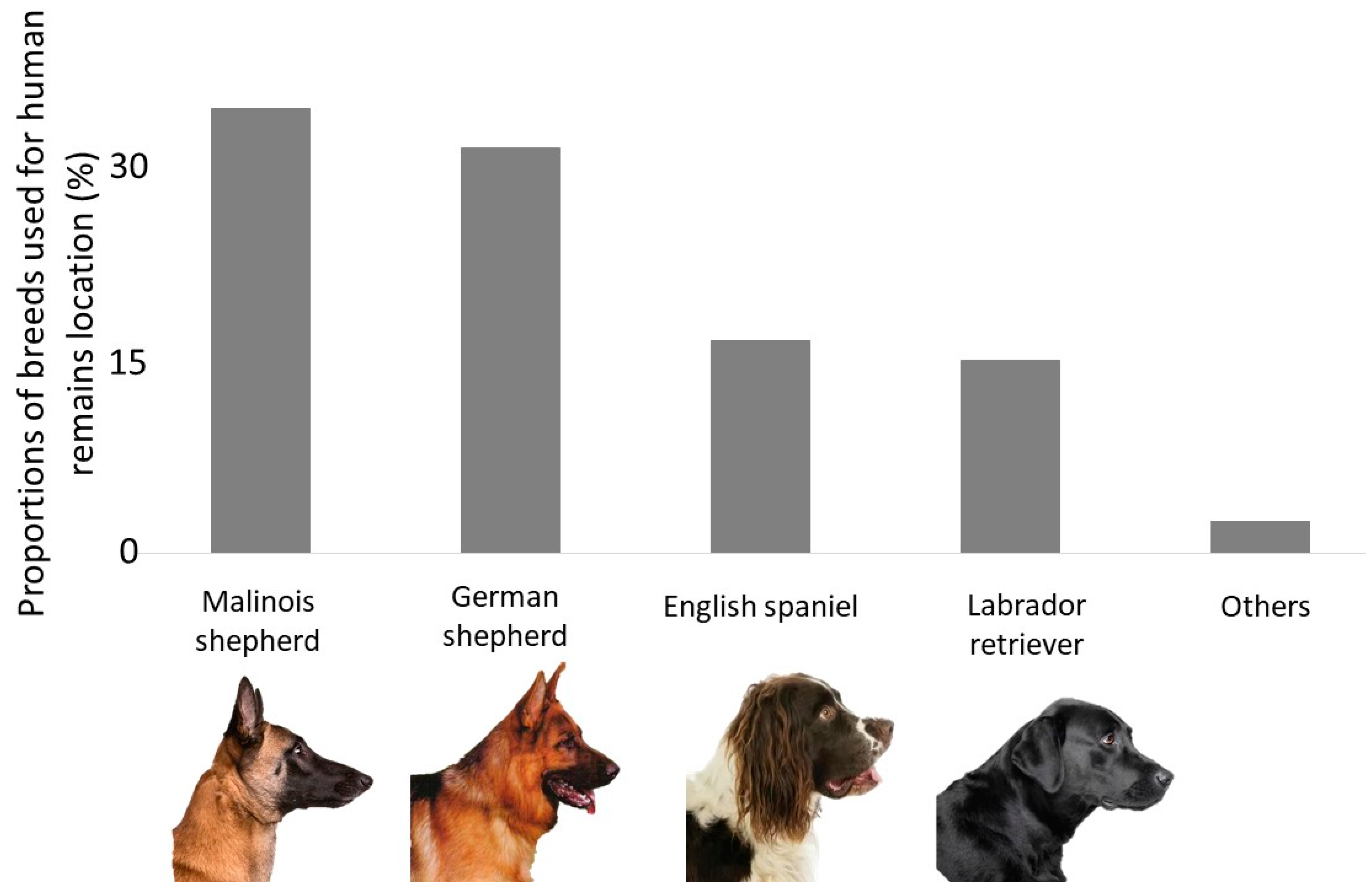
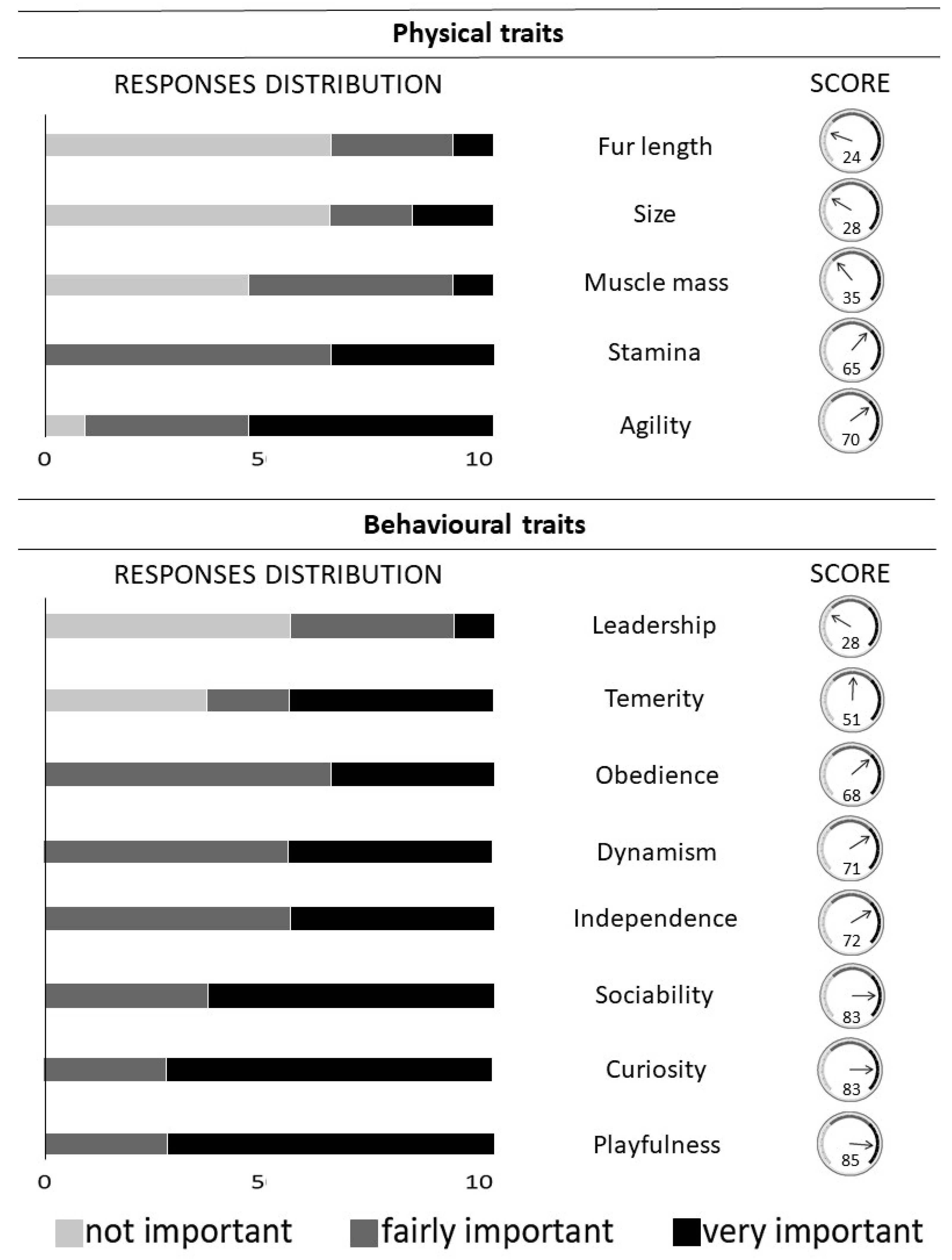
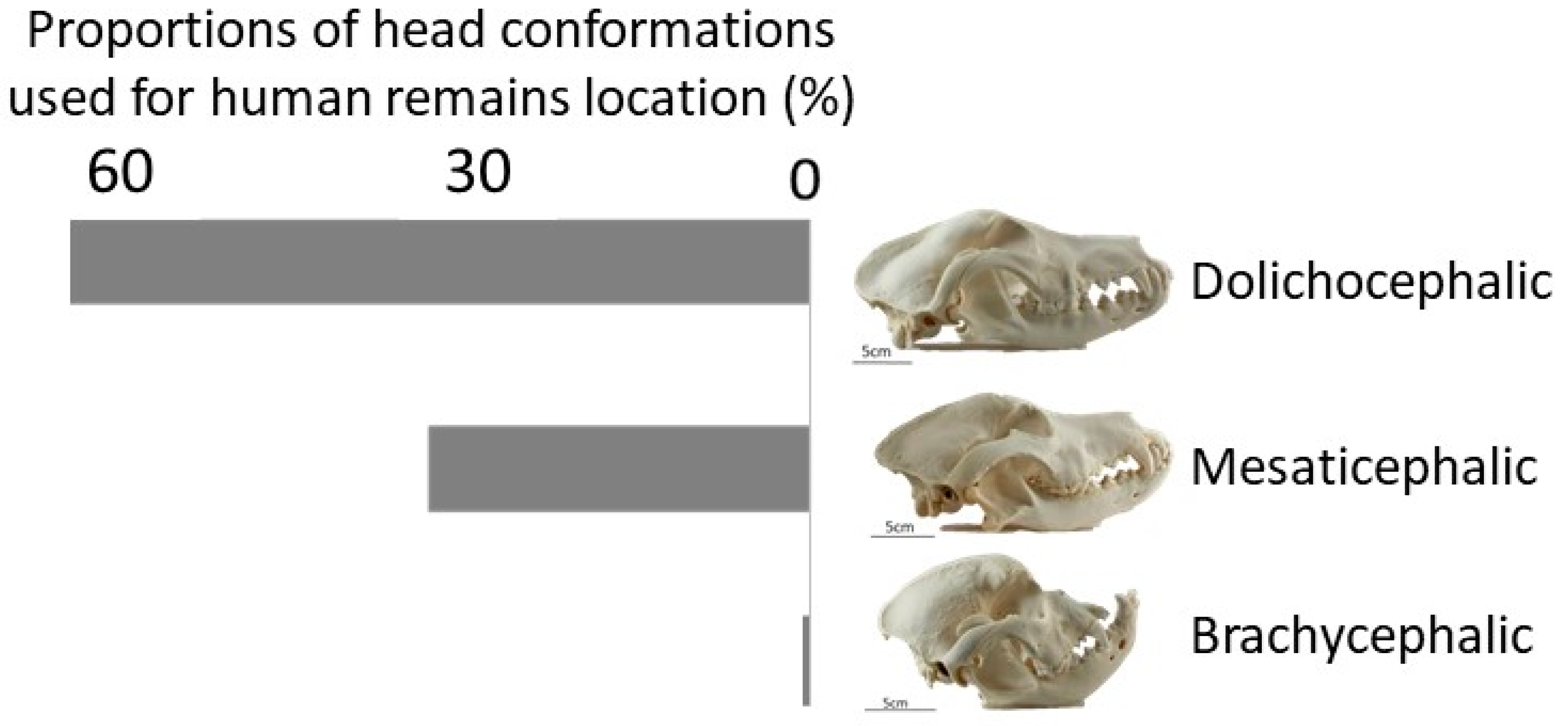
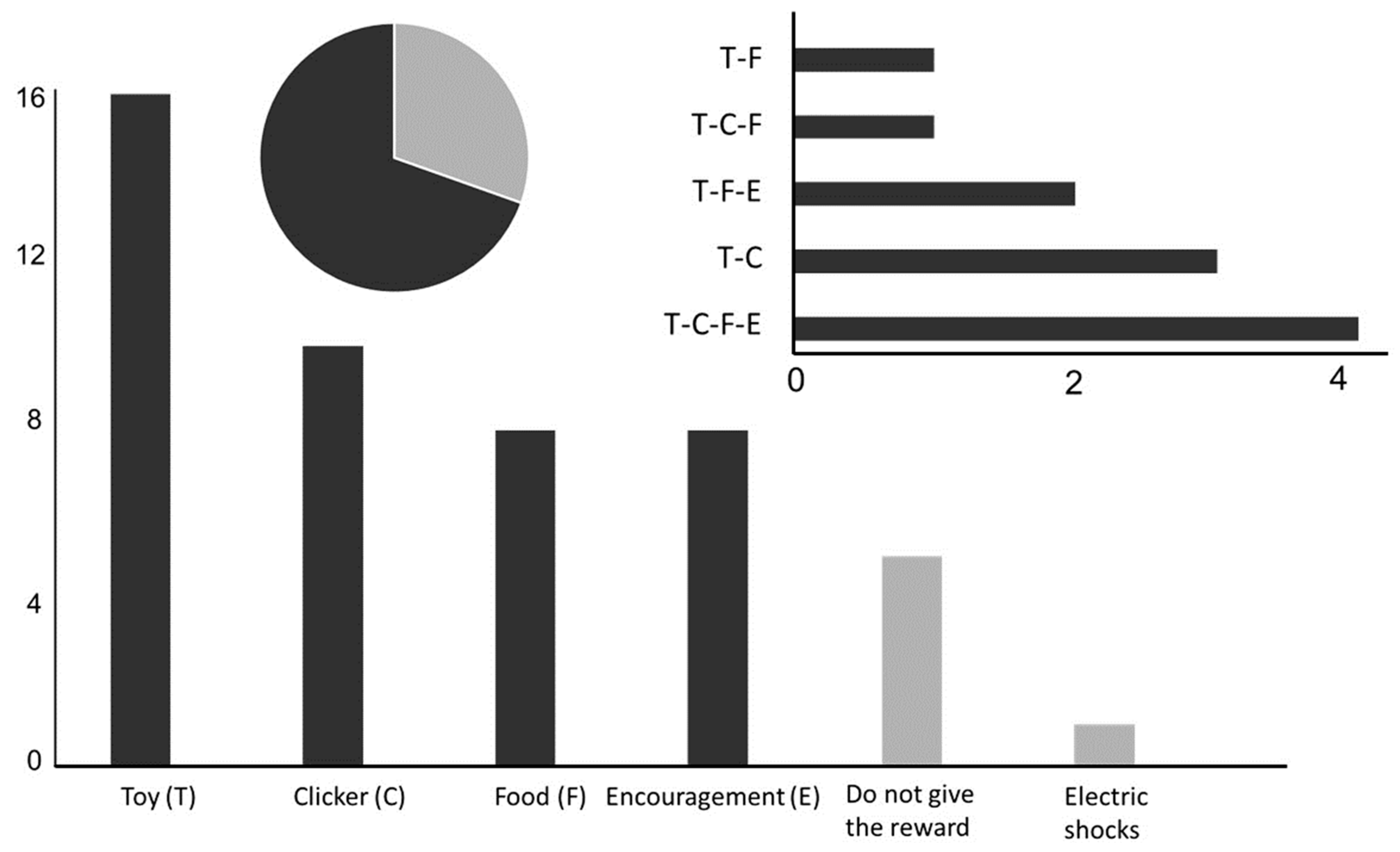
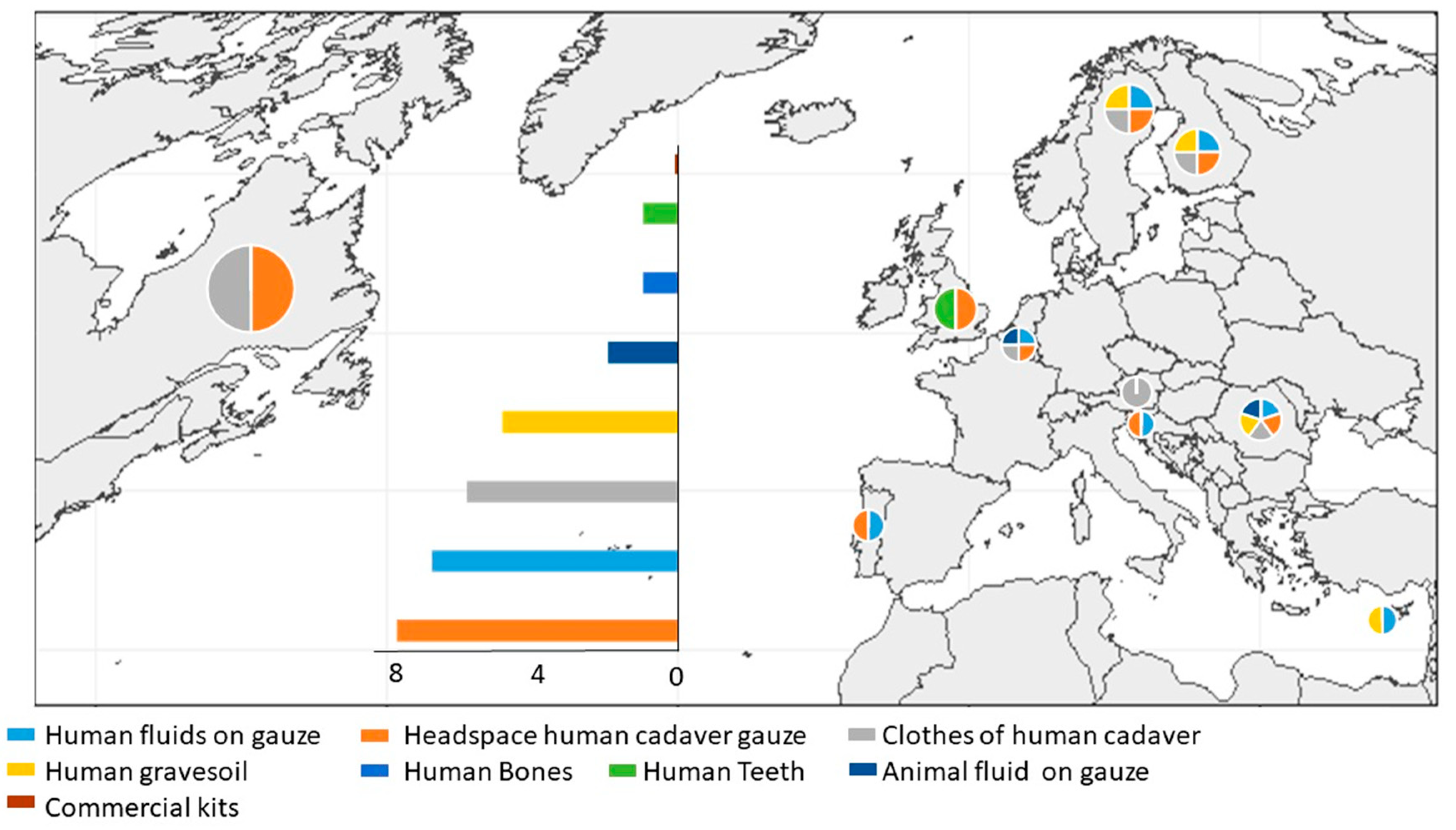
| Review Outline | Combinations of Keywords |
|---|---|
| Dog Selection | |
| Anatomical traits | Morphological: (selection AND suitable AND wildlife AND “detection dogs”) |
| Olfactory: (selection AND “detection dog” AND ((olfaction OR “Olfactory system”) OR (“genetic marker”)) | |
| Behavioral traits | (selection AND (“detection dog” OR “scent detection dog”) AND “behavio(u)ral trait”) |
| Methods | (selection AND (method OR methodology) AND police AND forensic AND “detection dog” AND (method OR procedure OR methodology)) |
| Dog Training | |
| Methods | (“human remains searching dog” OR “cadaver dog”) AND (“training procedure” OR “training method” OR “training methodology”) |
| Training aids | ((“human remains searching dog” OR “cadaver dog”) AND “training aid”) |
| Survey Outline | Questions |
| Selection | |
| Anatomical traits considered during the selection of HRDDs | Q1: What are the physical characteristics you are paying attention to when you select a dog to train? (for each trait, select among: very important/important/not important) Size Length and thickness of the fur Ability to run Muscle mass Q2: How do you assess the physical characteristics? |
| Behavioral traits considered during the selection of HRDDs | Q3: What are the behavioral characteristics you are paying attention to when you select your searching dogs? (for each trait, select among: very important/important/not important) Dominant Social Curious Dynamic Player Independent Obedient Adventurous Q4: How do you assess these behavioral characteristics? |
| Training | |
| Q5: What kind of training do you perform? Punishment (including take off the toy). If yes: What kind of punishment? (electric shock/strike/other) Reward. If yes: Which kind of reward? (Toy/vocal encouragement/food/clicker/other) Q6: What is the duration of a training session (in minutes)? Q7: What kind of training aids do you use? Compress with human cadaveric fluids Compress introduced in a container with human organs and/or blood Compress with animal cadaveric fluids Clothes wear by human cadaver Gravesoil Commercial kit Q8: Could you describe your trainings? Q9: If you use biological training aids (compress with cadaveric fluid, gravesoil or clothes…), can you describe how you obtain the final trainings aids? | |
| Characteristics | Description (According to Authors) | Method | ||||
|---|---|---|---|---|---|---|
| C-Barq | SDTC | IFT | M-B Scale | GDTP | ||
| Drive | ||||||
| Causal reasoning | Use of visual and auditory cues to infer the location of hidden reward | ∆ | ∆ | |||
| Commitment to toy | Tendency to engage game with its handler (new toys or familiar toys) | ∆ | ∆ | ∆ | ||
| Retrieval inhibition | Ability to inhibit prepotent motor response in object retrieval task | ∆ | ||||
| Energy level | Show enthusiasm and be always ready to play | ∆ | ||||
| Excitation | Before a walk or when owner/visitor is coming home | ∆ | ||||
| Gaze direction | Ability to use human gaze direction to locate hidden reward | ∆ | ∆ | |||
| Hiding-finding | Object permanence | ∆ | ∆ | |||
| Hunting behaviour | Tendency to track its prey directly or after a turnaround of 360° | ∆ | ∆ | ∆ | ||
| Odour control trials | Control trials ruling out ability to locate hidden food using olfaction | ∆ | ∆ | |||
| Perspective-taking | Tendency to obey/disobey a command depending on whether a human is watching | ∆ | ∆ | |||
| Play with stranger | Tendency to play with familiar toy and stranger | ∆ | ∆ | |||
| Reaching | Ability to infer reward location based on experimenter’s reaching towards baited location | ∆ | ||||
| Retrieval | Tendency to retrieve object and return it to in front of experimenter | ∆ | ∆ | ∆ | ||
| Reward preference | Preference for food or toy reward | ∆ | ||||
| Rotation | Egocentric vs. allocentric use of spatial cues | ∆ | ||||
| Social referencing | Tendency to look at human face when joint social activity is interrupted | ∆ | ∆ | |||
| Spatial transpositions | Ability to track location of hidden reward across spatial transformations | ∆ | ||||
| Visual discrimination | Ability to learn arbitrary visual discrimination prediction reward location | ∆ | ||||
| Nerve strength | ||||||
| Affect discrimination | Preference to approach unfamiliar human | ∆ | ∆ | ∆ | ∆ | ∆ |
| Confidence on rough surface | Ability to stay confident on rough surface | ∆ | ||||
| Confined space | Ability to come from a confined space and enter a lighted area and dark area | ∆ | ||||
| Fearfulness | Shaking/salivating/agitation/loss of appetite when they are left on its own | ∆ | ||||
| Laterality: first step | Forelimb preference when initiating a step off a platform | ∆ | ∆ | ∆ | ||
| Sociability towards other canines | Preference to approach unfamiliar canine | ∆ | ∆ | ∆ | ||
| Sound sensitivity | Ability to stay confident when confronted to several sounds | ∆ | ∆ | ∆ | ∆ | |
| Stability | Ability to stay confident and stable on unstable surface | ∆ | ||||
| Surface sensitivity | Ability to travel across a slick surface | ∆ | ||||
| Threating situation | With stranger, unfamiliar dog or object | ∆ | ∆ | |||
| Touch anxious | Tendency to stay calm when manipulated by human | ∆ | ∆ | |||
| Visual sensitivity | Ability to stay relaxed and confident in an area full of smoke | ∆ | ∆ | |||
| Trainability | ||||||
| Arm pointing | Ability to use human arm pointing to find a hidden reward | ∆ | ||||
| Detour navigation | Navigation of shortest route around an obstacle | ∆ | ||||
| Inferential reasoning | Ability to infer the location of hidden reward through the principle of exclusion | ∆ | ||||
| Marker cue | Ability to infer location of hidden reward when human uses a novel communicative marker | ∆ | ||||
| Memory-distraction | Memory for location of reward across delays while dog’s attention is discarded | ∆ | ||||
| Odour discrimination | Discrimination and memory for which of two locations is baited using olfaction | ∆ | ||||
| Response to command | Ability to sit/stay | ∆ | ||||
| Spatial perseverations | Ability to inhibit previously established motor pattern when environment changes | ∆ | ||||
| Working memory | Memory for location of reward across temporal delays | ∆ | ||||
| Personality | ||||||
| Attachment | Sign of attention to the owner | ∆ | ||||
| Begging for food | When people are eating | ∆ | ||||
| Contagious yawing | Tendency to yawn during auditory exposure to human yawning vs. control sounds | ∆ | ||||
| Dynamism | Hyperactive or restless | ∆ | ||||
| Escapes | Take each opportunity to escape | ∆ | ||||
| Olfactory interest | Rolls when facing smelly substance | ∆ | ||||
| Owner direct aggression | Tendency to be aggressive with owners during daily tasks (batch, eating, game…) | ∆ | ||||
| Steal behaviour | Steal food | ∆ | ||||
| Unsolvable task | Help seeking from human vs. independent behaviour when facing unsolvable task | ∆ | ||||
| Morphological | ||||||
| Physical exam | Examination of the body tension | ∆ | ||||
| Others | ||||||
| Barks | To alarm or when excited | ∆ | ||||
| Coprophagy | Eat its own faeces or of another animal | ∆ | ||||
| Licking | Itself or people or object | ∆ | ||||
| Pull on leash | During walk | ∆ | ||||
| Sensory bias | Prioritization of visual vs. olfactory information when senses pitted against one another | ∆ | ||||
| Transparent obstacle | Ability to inhibit direct approach to experimenter when a detour is required | ∆ | ||||
| Urinates | During night, when owner approaches, on object | ∆ | ||||
© 2020 by the authors. Licensee MDPI, Basel, Switzerland. This article is an open access article distributed under the terms and conditions of the Creative Commons Attribution (CC BY) license (http://creativecommons.org/licenses/by/4.0/).
Share and Cite
Martin, C.; Diederich, C.; Verheggen, F. Cadaver Dogs and the Deathly Hallows—A Survey and Literature Review on Selection and Training Procedure. Animals 2020, 10, 1219. https://doi.org/10.3390/ani10071219
Martin C, Diederich C, Verheggen F. Cadaver Dogs and the Deathly Hallows—A Survey and Literature Review on Selection and Training Procedure. Animals. 2020; 10(7):1219. https://doi.org/10.3390/ani10071219
Chicago/Turabian StyleMartin, Clément, Claire Diederich, and François Verheggen. 2020. "Cadaver Dogs and the Deathly Hallows—A Survey and Literature Review on Selection and Training Procedure" Animals 10, no. 7: 1219. https://doi.org/10.3390/ani10071219
APA StyleMartin, C., Diederich, C., & Verheggen, F. (2020). Cadaver Dogs and the Deathly Hallows—A Survey and Literature Review on Selection and Training Procedure. Animals, 10(7), 1219. https://doi.org/10.3390/ani10071219






